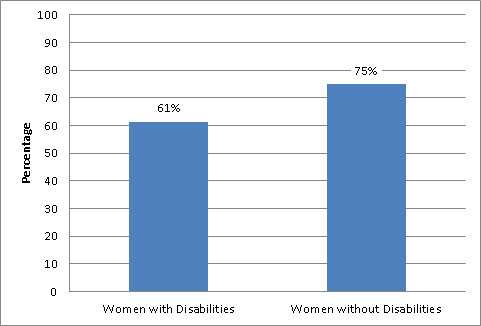Women with Disabilities and Breast Cancer Screening
Finding Breast Cancer Early Can Save Lives
Breast cancer is the most common type of cancer among women in the United States, and the second leading cause of cancer-related deaths. Thinking “breast cancer won’t happen to me” is a risk no woman should take. Having a screening mammogram regularly is an important way to maintain good health. A mammogram, which is an X-ray picture of the breast, is the best way to find breast cancer early, when it is easiest to treat and before it is big enough to feel or cause symptoms.
- If breast cancer is found early, treatment can have a greater chance for success.
- Many women who are diagnosed with and treated for breast cancer live long and healthy lives.
Women with Disabilities Are Less Likely to Have Received a Mammogram During the Past Two Years1
Breast Cancer Screening Recommendations2
If you are between the ages of 50-74 years, be sure to have a screening mammogram every two years. If you are between the ages of 40-49 years, talk to your doctor about when and how often you should have a screening mammogram.
Percentage of U.S. Adult Women 50-74 Years of Age Who Received a Mammogram During the Past 2 Years, By Disability Status – 2010 National Household Interview Survey(NHIS)*

* CDC/NCHS. National Health Interview Survey Data, 2010.3
CDC is Working to Improve the Use of Mammography Among Women with Disabilities
CDC, in coordination with its partners, is working to help more women with disabilities get screened for breast cancer. Here are a few examples:
- “Every Woman Matters: Portraits of Montana Women Living with Disabilities” is a multimedia exhibit created by The Montana Disability and Health Program to highlight the importance of breast cancer screening among women with physical disabilities. Holy Rosary Healthcare in Miles City, Montana hosts the exhibit as part of its ‘Pink Night Out’ breast cancer awareness event. Information on where to find and plan for accessible mammography is organized in the on-line Montana Mammography Directory.
- The New York Department of Health (NYSDOH) Disability and Health Program has worked closely with the NYSDOH Breast and Cervical Cancer Early Detection Program (BCCEDP) to increase providers’ understanding on how to better serve women with disabilities. A continuing education module was developed for providers, and a question regarding the need for an accommodation was added to the 1-800 number to access BCCEDP services.
- The Oregon Office on Disability and Health has a directory to better inform Oregon women with disabilities of the accessibility/usability features of their area mammography facilities. They are working with one of their regional Americans with Disabilities (ADA) centers on promoting their accessibility resources for facilities interested in improving ADA accessibility.
- The Association of Maternal & Child Health Programs (AMCMP)’s TOOLBOX provides links to tools that will increase knowledge about recommended services, identify service gaps, identify accessible healthcare facilities and transportation, and improve healthcare interactions between clinicians and women with disabilities.
- CDC’s “Breast Cancer Screening: The Right To Know” Campaign raises awareness about breast cancer among women with physical disabilities and encourages women to get screened. The campaign developed a family of health promotion materials and featured four women with physical disabilities who have survived breast cancer.
Getting Screened: Tips for Women with Disabilities
If you are a woman living with a disability, you may face challenges that make it hard to get a mammogram. Here are some questions to ask when scheduling your mammogram that can help you prepare for your appointment:
- How should I dress?
- How do I prepare if I use a wheelchair or a scooter?
- Can the machine be adjusted so I can remain seated?
- How long is the appointment and can I have more time if I need it?
Let the scheduling staff, radiology technicians, or radiologist know if you can/cannot:
- Sit upright with or without assistance.
- Lift and move your arms.
- Transfer from your chair/scooter.
- Undress/dress without assistance.
When preparing for your mammogram, remember:
- Wear a blouse that opens in the front.
- Wear a bra that you can remove easily.
- Do not wear deodorant or body powder.
- If you have any disability-related concerns, discuss them with your primary care physician, women’s health specialist, radiologist, physician’s assistant, or other healthcare professional.
Resources
CDC’s Campaign: “Breast Cancer Screening: The Right to Know.”
CDC’s Disability and Health Information
CDC’s Basic Breast Cancer Information
CDC’s Breast Cancer Screening Information
U.S. Preventive Services Task Force Summary of Recommendations on Breast Cancer Screening
References
- Courtney-Long E, Armour B, Frammartino B, Miller J. Factors associated with self-reported mammography use for women with and women without a disability. Journal of Women’s Health. 2011; 20:1279-1286.
- Screening for Breast Cancer, Topic Page. July 2010. U.S. Preventive Services Task Force. http://www.uspreventiveservicestaskforce.org/uspstf/uspsbrca.htm
- Data File Documentation, National Health Interview Survey, 2010 (machine readable data file and documentation). National Center for Health Statistics, Centers for Disease Control and Prevention, Hyattsville, Maryland. 2010. Disclaimer: The NHIS analyses in this report are those of the authors and not NCHS, which is responsible only for the initial data.
- Page last reviewed: August 3, 2017
- Page last updated: August 3, 2017
- Content source:




 ShareCompartir
ShareCompartir